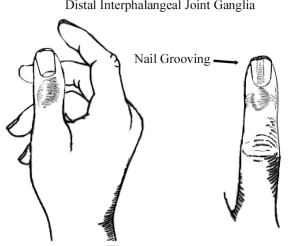Ganglion & Mucous Cysts
What is a Ganglion/Mucous Cyst ?
 Ganglion (or mucous) cysts of the small joint of the finger occur in people over 40 years of age and are associated with early underlying arthritis. These cysts may put pressure on the nailbed and cause grooving of the nail. It is uncommon to have more than one of these cysts. The cysts often leak a thick gel onto the nail and decrease in size for a time then gradually swell again.
Ganglion (or mucous) cysts of the small joint of the finger occur in people over 40 years of age and are associated with early underlying arthritis. These cysts may put pressure on the nailbed and cause grooving of the nail. It is uncommon to have more than one of these cysts. The cysts often leak a thick gel onto the nail and decrease in size for a time then gradually swell again.
How is it treated?
Non-operative treatment
Ganglion cysts often change in size and may even disappear spontaneously. For this reason, if the ganglion is not symptomatic, it may be best to simply wait. Being prominent on the fingers, mucous cysts are often frequently knocked during daily activities which causes pain and is the reason many people wish to have them removed. They are harmless and do not need to be removed if they are not causing symptoms
Surgical treatment
Surgical treatment involves day surgery to remove the mucous cyst from the joint and any osteophytes (arthritic bony spurs) that may be present. It can be performed under general or local anaesthetic with sedation. Removing the bone spurs stimulates a healing response and fibrous tissue formation to prevent the mucous cyst recurring. A bulky bandage is applied to the finger and extends to the wrist.


Risks
There is an approximately 10% risk of the cyst returning. There is a 1% risk of infection usually only requiring antibiotic tablets. Joint stiffness is possible but usually avoided by doing the exercises, using a heat pack and taking regular paracetamol until full recovery. Very rarely deep infect could require surgery to wash out the joint and longer-term antibiotic treatment
Recovery
2 weeks: Stitches and bandage are removed. Home exercises started. Finger may get wet and a light Coban dressing will be used to control swelling. The joint will be stiff and take several weeks to improve. Occasionally hand therapy may be required. Use of a heat pack and Panadol is encouraged to improve movement.
8 weeks: Most movement is recovered, and hand is being used for all daily activities.
4 mths: All swelling, pain and stiffness resolved with normal use of hand.

